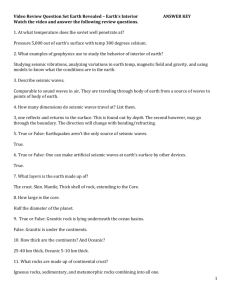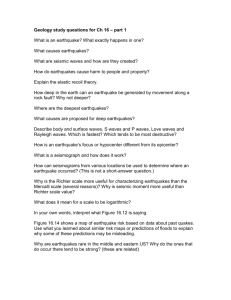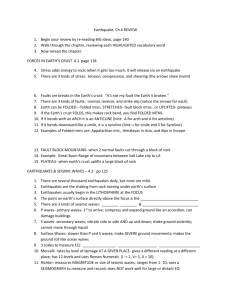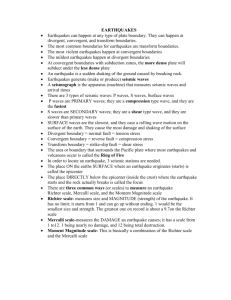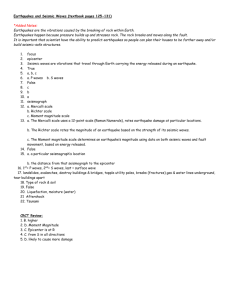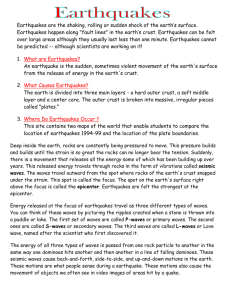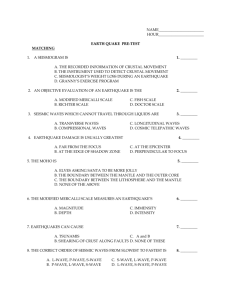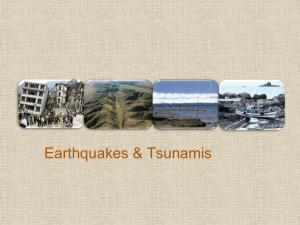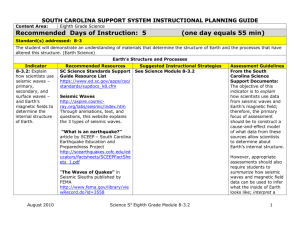Lecture 2 The Earth. I. The Interior Earth – vital statistics Planet size
advertisement
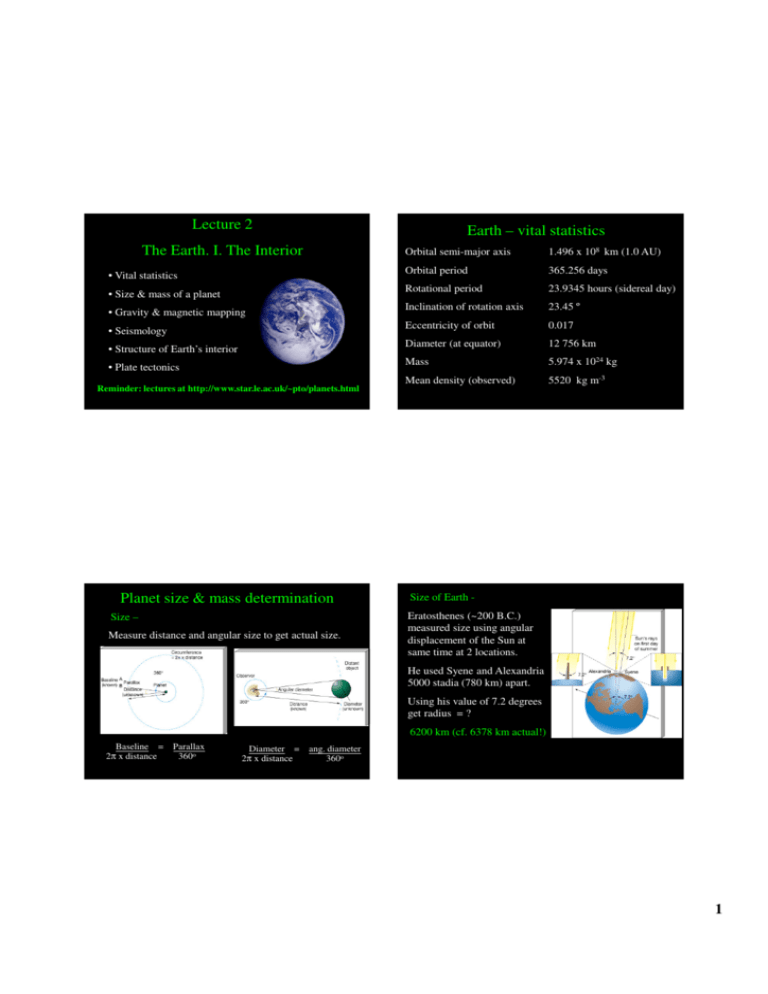
Lecture 2 The Earth. I. The Interior • Vital statistics • Size & mass of a planet • Gravity & magnetic mapping • Seismology • Structure of Earth’s interior • Plate tectonics Reminder: lectures at http://www.star.le.ac.uk/~pto/planets.html Planet size & mass determination Size – Measure distance and angular size to get actual size. Earth – vital statistics Orbital semi-major axis 1.496 x 108 km (1.0 AU) Orbital period 365.256 days Rotational period 23.9345 hours (sidereal day) Inclination of rotation axis 23.45 º Eccentricity of orbit 0.017 Diameter (at equator) 12 756 km Mass 5.974 x 1024 kg Mean density (observed) 5520 kg m-3 Size of Earth Eratosthenes (~200 B.C.) measured size using angular displacement of the Sun at same time at 2 locations. He used Syene and Alexandria 5000 stadia (780 km) apart. Using his value of 7.2 degrees get radius = ? 6200 km (cf. 6378 km actual!) Baseline = Parallax 2π x distance 360o Diameter = ang. diameter 2π x distance 360o 1 Determine the Astronomical Unit Mass – Newton’s laws of motion: Use radar and apply Newton/Kepler’s laws: Bodies of masses M and m in an elliptical orbit: Bounce radar off Venus. M+m = 4π2a3/GP2 and 1 AU = 149,597,870.7 km M/m = rm/rM Where P = period, a = semi-major axis and Now defined by IAU rm and rM = distance of M and m from the centre of mass. If m << M then a3∝ P2 ⇒ Kepler’s third law. Back to observed density of Earth…(5520 kg m-3) Uncompressed densities of some important compounds Substance Formula Density (kg m-3) Liquid water H2 O 998 Hydrated minerals X(H2O)n (X is rock, n≥1) Diopside (a pyrozene) CaMgSi2O6 <2000 Forsterite (an olivine) Mg2SiO4 3270 Alkali feldspars (Na, K)AlSi3O8 4740 Iron-nickel Fe + 6% Ni 7925 3200 Gravity Mapping Australia: Red = stronger g Blue = weaker g Geoid is the surface of equal g Small variation in gravitational acceleration. Can also be used to map Ocean/Ice levels. 2 Magnetic Mapping Earthquakes and Seismology Boxing Day 2004 earthquake, magnitude 9.1, Indian Ocean – largest earthquake for 40 years, lasted ~10 minutes Australia: Red = stronger Blue = weaker Presume planets with strong magnetic field have an internal dynamo converting the kinetic energy of a conducting, moving fluid into magnetic energy. ⇒ Strong evidence for molten material inside Earth Two main types of seismic waves • Primary (P) are longitudinal pressure waves • Secondary (S) are transverse sheer waves Seismic recording from two islands in the Indian Ocean: Cocos Island and Diego Garcia (~1000 km apart) Observed seismic waves • P waves travel at 5-6 km s-1 . Go through solids, liquids and gases. • S waves travel at 3-4 km s-1 . They cannot pass through liquid. • “Shadow zone” receives neither P nor S waves (refraction/liquid). Waves speed varies due to differences in density (faster at lower density) and temperature (refraction). • Faint P waves seen in the shadow zone must have been reflected off an inner solid core. 3 Earth – the present Most geological activity occurs at plate boundaries. Most boundaries are “compression boundaries” marked by mountain ranges where plates collide (e.g. Himalayas) and/or deep trenches, where old crust is subducted (e.g. Peru-Chile Trench). Cause the deepest and strongest earthquakes (~700 km) Earth sea-floor crustal age: Red = young (10 Myr); blue = old (200 Myr) “Extension boundaries” due to separation of plates on the ocean floor (e.g. mid-Atlantic ridge). Form new crust from the mantle material. Determine age from magnetic striping and radioactivity. Shallow earthquakes (<25 km). Tectonic activity can resurface most of the Earth in ~500 Myr Also have “transform boundaries” where plates slip past each other (e.g. San Andreas fault). Shallow, violent earthquakes. 4 Volcanoes • Near plate boundaries – magma comes up due to stress fracture in crust. Etna (left) is an example. • Over hot-spot – a buoyant mantle plume. Hawaiian island chain best example, e.g. Kilauea (right). Hot spot moves creating “chain”. Highest most recent – hence “Big Island”. Terrestrial Impact Craters Barringer Meteor crater, Arizona Radius 0.6 km, Age 0.05 Myr Chicxulub, Yucatan Peninsula Radius 85 km, Age 65 Myr Few craters (<200) known on Earth due to erosion (weathering), volcanic resurfacing and tectonic activity. Most < 500 Million years old. Oldest ~2 billion years old. If impact crater size > 1 km object impactor melts completely. Should we be worried…? The End 5



